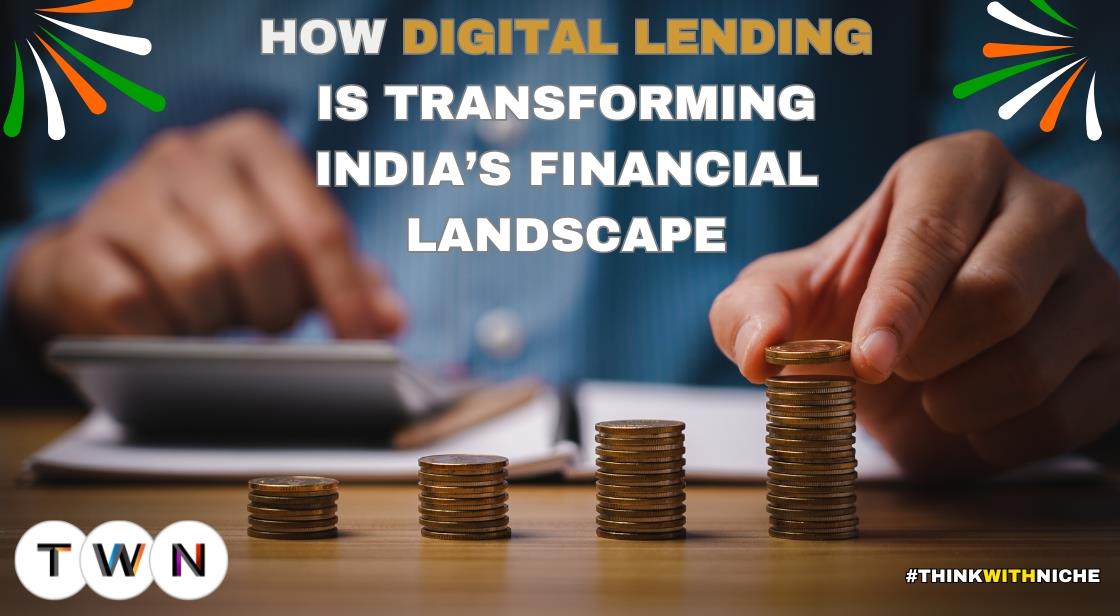How Digital Lending Is Transforming India’s Financial Landscape

Blog Post
Digital lending is revolutionizing India’s financial landscape by making credit more accessible, faster, and highly efficient. With the rapid adoption of technology, the lending ecosystem has evolved beyond traditional banking methods, leveraging automation, artificial intelligence (AI), and big data analytics to simplify and speed up loan approvals.
This transformation has enabled borrowers—both individuals and businesses—to access financial support conveniently, often with just a few clicks from their smartphones or computers.
India’s digital lending sector has witnessed remarkable growth, fueled by increased internet penetration, the rise of fintech startups, and a growing demand for hassle-free credit solutions.
Unlike conventional lending, which involves extensive paperwork and long wait times, digital lending platforms offer instant loan approvals, flexible repayment options, and lower operational costs.
Various digital lending models, such as peer-to-peer (P2P) lending, marketplace platforms, and mobile money lenders, cater to diverse financial needs, ensuring a seamless borrowing experience.
As digital lending continues to reshape India’s financial ecosystem, it is crucial to strike a balance between innovation and responsible lending. While technology has expanded financial access, strong regulatory measures and financial literacy initiatives are essential to prevent fraud, protect borrowers, and ensure sustainable growth.
This article explores the rise of digital lending in India, its benefits, the latest innovations, and its long-term impact on the economy.
The Rise of Digital Lending and Its Role in India’s Economy
Digital lending has revolutionized India's financial ecosystem, providing faster, more accessible, and technology-driven solutions for borrowers and businesses. The digital transformation in lending is making loan applications easier, reducing paperwork, and increasing financial inclusion.
This shift is not only modernizing banking services but also addressing the credit needs of individuals and businesses efficiently.
Understanding Digital Lending
Digital lending has revolutionized the financial sector by making loan applications faster, more accessible, and efficient. It allows borrowers to apply for loans through online platforms, eliminating the need for extensive paperwork and multiple visits to a bank.
By leveraging advanced technologies such as artificial intelligence (AI) and big data analytics, digital lending simplifies the borrowing process, reduces costs, and enhances customer experience. Individuals and businesses can now access credit from the comfort of their homes with just a few clicks.
Types of Digital Lenders in India
Digital lending has evolved into a multi-faceted industry, catering to different borrowing needs. Here are some of the major types of digital lenders operating in India:
1. Online Lenders
These are independent platforms that provide various types of loans, including personal and business loans, through digital channels. Operating without physical branches significantly lowers operational costs and enhances efficiency.
2. Peer-to-Peer (P2P) Lenders
P2P lending platforms connect borrowers directly with individual investors, bypassing traditional financial institutions. This approach results in competitive interest rates and diversified risk-sharing among lenders.
3. Embedded Lending in E-Commerce and Social Platforms
Many e-commerce and social media platforms now offer embedded lending services, enabling consumers to access instant credit at the point of purchase. This not only enhances convenience but also boosts conversion rates for merchants.
4. Marketplace Lenders
These platforms act as intermediaries, aggregating loan options from multiple lenders. Borrowers can compare different loan products and choose the best one based on their credit profile, leading to more competitive terms and rates.
5. Supply Chain Lenders
Supply chain lending focuses on businesses, providing financing solutions tailored to supply chain operations. These loans ensure businesses maintain liquidity and effectively manage accounts payable.
6. Mobile Money Lenders
With the increasing adoption of mobile banking, some lenders offer mobile-first solutions, enabling users to apply for loans directly from their smartphones. This is particularly beneficial for borrowers in rural areas with limited access to traditional banking infrastructure.
7. Technology-Enabled Lenders
These lenders incorporate cutting-edge technology such as AI and machine learning to optimize lending processes. By automating risk assessments and fraud detection, they provide quicker approvals and seamless borrowing experiences.
Also Read: How Smart Technology Shapes the Future of Urban Infrastructure
Advantages of Digital Lending Platforms
Digital lending offers several benefits that set it apart from traditional lending practices. Here are some key advantages:
1. Speed and Efficiency
Traditional banks involve lengthy paperwork and long queues, whereas digital lending platforms use AI-driven analytics to process applications quickly, reducing approval times.
2. 24/7 Accessibility
Unlike conventional banks with fixed working hours, digital lending platforms are accessible anytime and anywhere, providing greater convenience to borrowers.
3. Lower Costs
Automation reduces manual intervention, minimizing operational costs. These savings enable lenders to offer more competitive interest rates and lower processing fees.
4. Enhanced Customer Experience
With user-friendly interfaces, borrowers can seamlessly apply for loans, track their applications, and manage repayments, improving overall customer satisfaction.
5. Competitive Interest Rates
Since digital lenders have lower overhead costs compared to traditional banks, they can offer more attractive interest rates and loan terms.
6. Increased Credit Accessibility
By eliminating geographical barriers, digital lending platforms expand credit access to a broader range of borrowers, including underserved communities and small businesses.
Key Features of Digital Lending Solutions
To remain competitive in the rapidly evolving digital lending space, platforms must offer advanced features that cater to customer needs:
1. Smart Onboarding
User-friendly interfaces allow borrowers to independently set up accounts, reducing onboarding time and simplifying the loan application process.
2. Digital Data Enrichment
By integrating diverse data sources, lenders can gain deeper insights into customer behaviors, enabling personalized loan offerings and informed decision-making.
3. Advanced Decision-Making
AI-driven decision engines analyze customer data in real-time to assess creditworthiness, enhancing the efficiency and accuracy of loan approvals.
4. Dynamic Activation
Lenders can tailor financial product activation criteria based on market conditions, risk assessments, and regulatory requirements, ensuring adaptive lending strategies.
5. Robust Management Systems
State-of-the-art banking infrastructure enables lenders to monitor, configure, and manage digital lending solutions effectively, enhancing operational efficiency.
The Role of Digital Lending in Risk Mitigation
Digital lending solutions incorporate sophisticated risk management mechanisms, ensuring safer lending practices:
1. Fraud Detection
AI-powered algorithms detect fraudulent activities by analyzing transaction patterns and borrower behavior, reducing financial risks.
2. Automated Credit Assessments
Data-driven credit scoring models provide lenders with real-time insights, enabling them to make informed decisions and reduce default risks.
3. Data Analytics for Better Lending Decisions
Lenders leverage analytics to track borrower behavior, predict repayment trends, and optimize lending policies for better risk management.
Digital Lending and Mobile Technology
With the rise of smartphones, mobile lending solutions have become increasingly popular, offering additional benefits:
1. Mobile Accessibility
Borrowers can apply for loans, check repayment schedules, and manage accounts via mobile applications, enhancing convenience and flexibility.
2. Real-Time Loan Tracking
Mobile-friendly dashboards enable borrowers to track loan status and repayment progress, ensuring transparency.
3. Seamless Integration with Other Financial Services
Many mobile lending apps offer additional features like bill payments and investment tracking, providing a holistic financial management experience.
How Digital Lending is Shaping India’s Financial Sector
Digital lending is playing a pivotal role in transforming India’s financial ecosystem, particularly in underbanked regions. The impact of digital lending can be observed in the following areas:
1. Expanding Financial Inclusion
Many individuals and small businesses in rural and semi-urban areas lack access to traditional banking services. Digital lending bridges this gap by providing easier access to credit.
2. Faster Access to Capital for Businesses
Small and medium enterprises (SMEs) often face challenges in securing quick loans. Digital lending platforms provide swift approvals, helping businesses seize growth opportunities.
3. Encouraging Economic Growth
By facilitating easier access to credit, digital lending stimulates entrepreneurship and boosts economic activity, contributing to India’s GDP growth.
4. Flexible Repayment Options
Many digital lenders offer customized repayment plans, allowing borrowers to choose flexible schedules that align with their financial capabilities.
5. Regulatory Challenges and the Need for Consumer Protection
Despite its advantages, digital lending must adhere to strict regulations to prevent unethical practices such as hidden charges and predatory lending. Ensuring transparency and consumer awareness is crucial for sustainable growth.
Best Digital Lending Platforms in India
India has witnessed a rapid rise in digital lending platforms, transforming the way individuals and businesses access credit. These platforms leverage cutting-edge technology such as artificial intelligence (AI), big data analytics, and automation to simplify and expedite the lending process.
By eliminating the need for extensive paperwork and reducing approval times, digital lending platforms have made borrowing more accessible, especially for small businesses and underserved individuals. Here’s a closer look at some of the top digital lending platforms in India and how they are reshaping the financial landscape:
1. Lendingkart
Lendingkart is a leading digital lending platform catering primarily to small and medium-sized enterprises (SMEs). It offers business loans of up to ₹1 crore with repayment tenures of up to 36 months. The platform utilizes AI-driven credit evaluation models to assess borrower eligibility quickly, enabling faster disbursal of funds without requiring collateral. This has made Lendingkart a go-to option for entrepreneurs seeking hassle-free access to working capital.
2. Pine Labs
Pine Labs is widely recognized for its payment solutions, but it also provides short-term working capital loans tailored to small businesses. Loan amounts range from ₹25,000 to ₹5 lakhs, with flexible tenures of up to 90 days. Pine Labs partners with banks and NBFCs to offer seamless credit solutions to merchants, helping them manage cash flow and business expenses efficiently.
3. MobiKwik
Initially known for its digital wallet services, MobiKwik has expanded into the digital lending space by offering instant personal loans. It provides quick access to funds without lengthy application processes, making it an attractive option for individuals in need of emergency financial assistance. MobiKwik's integration with various financial institutions allows users to access loans based on their spending habits and credit profiles.
4. Shiksha Finance
Shiksha Finance specializes in education loans, catering to students and educational institutions. It provides financial assistance to families for school fees, higher education expenses, and skill development courses. The platform also supports private educational institutions by offering loans for infrastructure development, ensuring better facilities for students.
5. MoneyTap
MoneyTap is an innovative digital lending platform that provides personal credit lines to users. Borrowers can access flexible personal loans with repayment options that suit their financial situation. Unlike traditional loans, MoneyTap allows users to withdraw funds as needed and pay interest only on the amount used, making it a cost-effective borrowing solution.
6. Paytm
One of India's most popular fintech companies, Paytm, has expanded beyond digital payments to include lending services. Through its financial arm, Paytm provides instant personal loans, targeting salaried individuals and small business owners. The platform's strong digital ecosystem enables seamless loan applications, quick approvals, and direct fund transfers to users' bank accounts.
7. PolicyBazaar
Although primarily an insurance marketplace, PolicyBazaar has ventured into digital lending by offering various loan products, including personal loans, home loans, and business loans. It acts as an aggregator, helping users compare loan options from multiple lenders to find the best interest rates and terms.
8. Capital Float
Capital Float is a leading provider of working capital loans for businesses. It offers short-term financing solutions, including invoice financing, merchant cash advances, and term loans. The platform serves SMEs, e-commerce sellers, and retail businesses, helping them scale operations by providing quick and collateral-free credit.
9. Faircent
Faircent is India's pioneering peer-to-peer (P2P) lending platform that connects borrowers directly with individual investors. By eliminating traditional banking intermediaries, Faircent enables competitive interest rates for borrowers while allowing investors to earn attractive returns. The platform follows strict risk assessment measures to ensure secure transactions for both parties.
How Digital Lending Platforms Are Transforming Credit Accessibility in India
The emergence of digital lending platforms has revolutionized the financial landscape by bridging the gap between borrowers and lenders. These platforms offer several advantages over traditional banking methods:
✅ Faster Loan Processing – Digital lenders use AI-powered credit assessments, enabling instant approvals and quick disbursals.
✅ Minimal Paperwork – The online application process eliminates cumbersome paperwork, making borrowing more convenient.
✅ Flexible Loan Options – Borrowers can choose from various loan products, including personal loans, business loans, education loans, and working capital loans.
✅ Better Financial Inclusion – Digital lending expands credit access to individuals and businesses in remote and underserved regions who may not have easy access to traditional banks.
✅ Lower Interest Rates – With reduced operational costs, many digital lenders offer competitive interest rates and flexible repayment options.
Final Thoughts
As digital lending continues to grow, it is playing a crucial role in fostering financial inclusion and supporting economic development. These platforms have made borrowing faster, more accessible, and highly efficient, benefiting both individuals and businesses.
However, regulatory oversight and responsible lending practices remain essential to ensure transparency and prevent financial risks. With continuous technological advancements, India's digital lending sector is poised to reshape the future of finance, driving economic progress and empowering millions of borrowers.
Conclusion
Digital lending has undeniably transformed India’s financial landscape, offering a seamless, efficient, and accessible alternative to traditional banking. By leveraging advanced technologies such as AI, big data, and automation, digital lenders have revolutionized loan processing, making it faster, more transparent, and cost-effective.
The diverse range of digital lending models—ranging from peer-to-peer lending to mobile-based credit solutions—has expanded financial inclusion, particularly for individuals and small businesses in underserved regions.
The benefits of digital lending extend beyond convenience. It fosters economic growth by providing timely access to credit, supports entrepreneurial ventures, and enhances consumer financial experiences.
Moreover, the integration of real-time data analytics and automated risk assessment has strengthened decision-making, reducing fraud risks while ensuring responsible lending practices.
However, as the sector grows, maintaining a balance between innovation and regulation remains critical. Robust regulatory frameworks and consumer protection measures are essential to prevent predatory lending practices and ensure transparency.
Digital literacy initiatives and financial awareness campaigns will further empower borrowers, helping them make informed financial decisions.
In the coming years, digital lending will continue to evolve, playing a crucial role in shaping India’s digital economy. With the right blend of technology, regulation, and ethical lending practices, digital lending can drive financial inclusion, foster entrepreneurship, and contribute to India’s long-term economic growth.
Disclaimer: The information provided in this blog is for informational purposes only and should not be considered as financial advice. While we strive to keep the details accurate and up to date, digital lending platforms may change their terms, interest rates, and policies over time. Readers are advised to conduct their own research and consult financial experts before making any borrowing decisions. We do not endorse or promote any specific lending platform mentioned in this article. The use of any financial service is at the reader’s discretion and risk.
You May Like
EDITOR’S CHOICE












